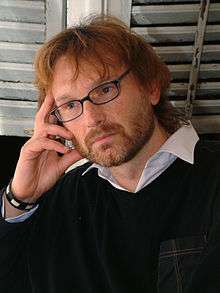Mario Kopić
| Mario Kopić | |
|---|---|
 | |
| Born |
March 13, 1965 Dubrovnik, Yugoslavia |
| Era | 21st-century philosophy |
| Region | Western Philosophy |
| School | continental philosophy, existentialism, phenomenology |
Main interests | Ethics, Religion, Culture |
Mario Kopić (born 13 March 1965) is a philosopher, author and translator. His main areas of interest include: History of Ideas, Philosophy of Art, Philosophy of Culture, Phenomenology and Philosophy of Religion.[1][2]
Kopić is influenced by and writes extensively on Friedrich Nietzsche, Martin Heidegger, Hannah Arendt, Jacques Derrida, Gianni Vattimo, Reiner Schürmann and Dušan Pirjevec. He also translated works by Nietzsche (Thus Spoke Zarathustra, On the Genealogy of Morality), Giorgio Agamben, Gianni Vattimo, Jacques Derrida and Dušan Pirjevec into Croatian.
Life and work
Mario Kopić was born in Dubrovnik, Croatia. He studied Philosophy and Comparative Literature at the University of Zagreb; Phenomenology and Anthropology at the University of Ljubljana; History of Ideas at the Institute Friedrich Meinecke at the Free University of Berlin (under the mentorship of Ernst Nolte); and Comparative Religion and Anthropology of religion at the Sapienza University of Rome (under the mentorship of Ida Magli).[3]
Mario Kopić's philosophical work is under the influence of the Italian philosophical approach known as pensiero debole[4] or "weak thought", the political thought of Arendt,[5][6] and the ethical-political thought of late Derrida.[7]
In his latest works The Unhealable Wound of the World, The Challenges of the Post-metaphysics, Sextant and The Beats of the Other Kopić developed a kind of onto-politics of liberal-conservative postmodernism and the post-anthropocentric humanism.[8] For him the world is the space of being as event, and only then the arena of national and social or political conflict.[9] The world, or existence, is our ontological responsibility, which precedes political, judicial and moral responsibility.[10]
Kopić appears in Igor Ivanov Izi's 1995 film N.E.P.[11]
Published books
- Art and Philosophy: An Anthology (Filozofija i umjetnost - Antologija), Delo 11-12 /1990, Belgrade 1990.
- Experiencing the Margins of the Sense (Iskušavanje rubova smisla: pabirci iz estetike), Dubrovnik 1991.
- With Nietzsche on Europe (S Nietzscheom o Europi), Zagreb 2001.
- Nietzsche and Evola: The Thought as Destiny (Nietzsche e Evola: il pensiero come destino), Rome 2001.
- A Trial to the West (Proces Zapadu), Dubrovnik 2003. ISBN 953-7089-02-9
- The Challenges of the Post-Metaphysics (Izazovi post-metafizike), Sremski Karlovci - Novi Sad 2007. ISBN 978-86-7543-120-6
- The Unhealable Wound of the World (Nezacjeljiva rana svijeta), Zagreb 2007. ISBN 978-953-249-035-0
- Gianni Vattimo Reader (Ed.),(Gianni Vattimo: Čitanka (Ur.)), Zagreb 2008. ISBN 978-953-249-061-9
- Dušan Pirjevec, Death and Nothing (ed.), (Smrt i niština, (Ur.)) Zagreb 2009. ISBN 978-953-225-124-1
- Sextant: The Outlines of the Spiritual Foundations of the World (Sekstant: Skice o duhovnim temeljima svijeta), Belgrade 2010. ISBN 978-86-519-0449-6
- The Beats of the Other (Otkucaji drugoga), Belgrade 2013. ISBN 978-86-519-1721-2
- The Windows: Essays on Art and Literature (Prozori: Ogledi o umjetnosti), Dubrovnik 2015. ISBN 978-953-7835-24-8
See also
- Continental philosophy
- Deconstruction-and-religion
- Postmodern Christianity
- Ontotheology
- Phenomenology (philosophy)
- Phenomenology of religion
References
- ↑ http://www.zarez.hr/clanci/razgovor-s-mariom-kopicem
- ↑ http://www.danas.rs/dodaci/vikend/knjiga_danas/ili_cemo_naci_smisao_ili_cemo_se_izgubiti
- ↑ http://www.hrvatskodrustvopisaca.hr/hr/dogadanje/biblioteka-tvrda-nova-knjiga-marija-kopica-117
- ↑ http://www.odjek.ba/?broj=16&id=17
- ↑ http://pescanik.net/2011/10/hannah-arendt-lijevo-ili-desno/
- ↑ http://pescanik.net/2010/12/misljenje-bez-sjaja-slave/
- ↑ http://pescanik.net/2013/08/mislilac-nove-eticnosti/
- ↑ http://www.komunikacija.org.rs/komunikacija/casopisi/fid/XXI_2/15/download_ser_lat
- ↑ http://www.odjek.ba/eng/index.php?broj=02&id=06
- ↑ http://zlaticahoke.blogspot.hr/2016/01/internet-and-philosophy.html/
- ↑ http://m.imdb.com/name/nm0465784/
Sources
- Interview with Mario Kopić, Zarez, 2008 (Croatian)
- Interview with Mario Kopić, Danas, 2010 (Serbian)
- Interview with Mario Kopić, Dubrovački list, 2011 (Croatian)
- Interview with Mario Kopić, Dubrovački list, 2015 (Croatian)
- Nezacjeljiva rana svijeta (Croatian)
- 2011 article by Mario Kopić about Hannah Arendt (Croatian)
- 2012 article by Mario Kopić about Heidegger (Croatian)
- 2013 article by Mario Kopić about Derrida (Croatian)
- 2015 article by Mario Kopić about Reiner Schürmann (Croatian)
External links
- Comments on Jacques Derrida's Les Spectres de Marx by Mario Kopić
- Kafka and Nationalism by Mario Kopić
- M. Kopić Heideggers Wiederholungsverständnis 2013. (German)
- M. Kopić Le peuple, la nation et l'(im)pouvoir 2012. (French)
- M. Kopić Paul Ricoeur – filozof čitanja 2005. (Croatian)